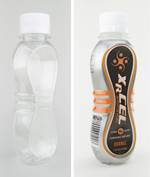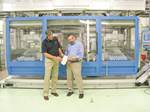Conveyor Upgrade Keeps Currier on Track
Processor’s switch to modular plastic belt conveyors increased efficiency in bottle making by eliminating downtime.
For more than 35 years, Currier Plastics Inc. of Auburn, N.Y. has relied on advanced equipment, statistical analysis, and precise traceability of products with a strict performance standard of zero defects in its injection and blow molding processes. Currier is a relatively small custom molder, but it competes in consumer and healthcare packaging markets served by firms many times its size, blowing bottles for personal care, beauty and cosmetics, household chemicals, and healthcare. So the processor leaves no stone unturned in an effort to make its operation as efficient as possible.
Efficiencies can be acquired in a variety of ways and Currier (currierplastics.com) places a strong emphasis on specifying equipment and machinery that is reliable and maintenance-free. By focusing on innovative technology and automation, the firm seizes opportunities to increase efficiencies while providing product quality and consistency.
Most recently it upgraded conveying technology for its blow molding operations. Currier utilizes belt conveyors to move the trimmed moils and tails away from its extrusion blow molding machines. Two conveyors are paired: one for getting the moils and tails out from under the machine; the other to feed this scrap into a grinder.
Sean Plantz, maintenance technician at Currier, says the two-belt conveyor system is the firm’s standard way of removing moils and tails as bottles are trimmed or deflashed. But Plantz was discouraged by the long lead times from their conveyor vendor for replacement parts and the lengthy repair process to change an endless belt. He was also frustrated with the overall constant care required to ensure that the conveyors were operating properly.
Currier Plastics learned from other molding companies about plastic modular belt conveyors offered by Dynamic Conveyor Corp. (DynaCon), Norton Shores, Mich., and decided to give them a try. Currier started by installing one 16-ft-long conveyor with a 45° angle under the molding machine for removing the moils and tails. “Because of the design of the DynaCon conveyors, we do not have to constantly stop to make sure parts aren’t getting wedged in the conveyor drives,” says Plantz.
Pleased with the results after just a few months of use, Currier added a second angle conveyor to the process, allowing scrap to be fed directly to the grinder. The second DynaCon conveyor includes a metal detector that safeguards the grinder by inspecting the scrap for impurities such as ferrous, non-ferrous and stainless metals.
Since purchasing Currier’s first DynaCon conveyor (dynamicconveyor.com), Plantz has seen a noticeable boost in efficiency. “We literally only work on the DynaCon conveyors when they are damaged by misuse. Otherwise, we do a regular cleaning, and put them back in production. It has been nice to come in on a Monday and not have to deal with three or more conveyors needing repair.”
Plantz adds, “Conveyor downtime has pretty much been eliminated by using DynaCon conveyors.” Elimination of conveyor downtime furthers Currier’s goal to reduce customer costs without compromising part quality.
Related Content
-
Multilayer Solutions to Challenges in Blow Molding with PCR
For extrusion blow molders, challenges of price and availability of postconsumer recycled resins can be addressed with a variety of multilayer technologies, which also offer solutions to issues with color, processability, mechanical properties and chemical migration in PCR materials.
-
Paperless ‘Smart Factory’ Based on Automated Production Monitoring
Tier 1 automotive molder’s home-built production-monitoring and ERP systems, designed for “the little guy,” boost its efficiency rating and profits.
-
Get Color Changes Right In Extrusion Blow Molding
Follow these best practices to minimize loss of time, material and labor during color changes in molding containers from bottles to jerrycans. The authors explore what this means for each step of the process, from raw-material infeed to handling and reprocessing tails and trim.







